Ranking the Top 50 Dungeons in the Zelda Series
Posted on May 27 2020 by Andy Spiteri
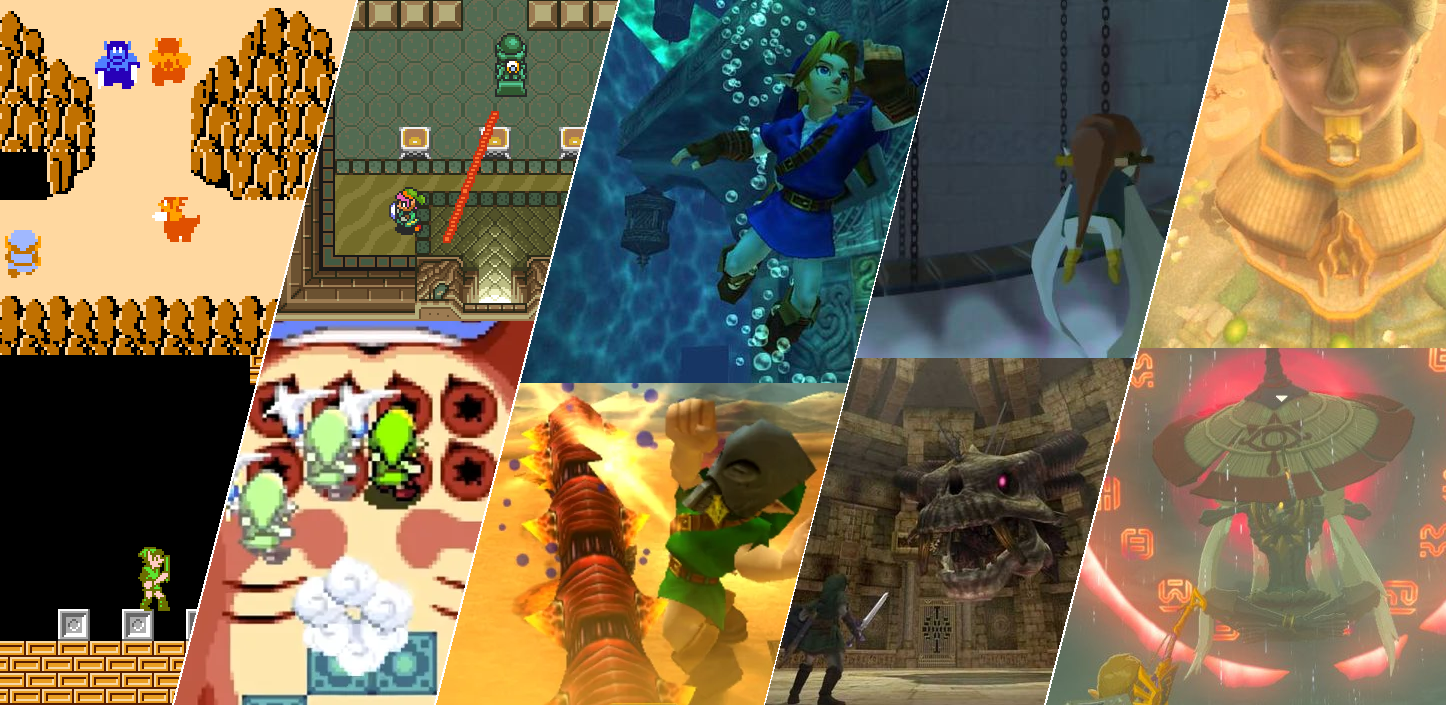
What is the greatest dungeon in the Zelda series?
A simple question on the surface, but one with so many layers that it makes finding an answer almost impossible. How does one define ‘great’? Is it the dungeon layout? Perhaps the ways the dungeon item is implemented into the puzzles? Or is it the bombastic boss fight at the end? Surely the music and overall aesthetic play a part? And to be honest – what does being a dungeon in the Zelda series even mean after Breath of the Wild? What we know as traditional dungeons didn’t exist in the latest Zelda entry; instead, they were broken up into bite size pieces and scattered across the map. Maybe the biggest factor – how do you separate players personal bias from objectively good or bad dungeons based on certain criteria? Or can you? Or should you?
These are all the reasons why answering that simple question is so, so hard. A dungeon in the Zelda series means different things to different players, and every dungeon is someone’s favorite.
So what is the greatest dungeon in the Zelda series? It’s impossible to tell… but we’re going to try!
Starting on June 1st, Zelda Dungeon is undertaking the daunting task of ranking the Top 50 dungeons in the Zelda series, as chosen by over 30 members of the Zelda Dungeon staff. We asked each staff member to submit in secret their Top 20 dungeons in the series – which is easier than it sounds – and left it up to them to come up with their own definition of ‘great’. Using the data we got from the staff, we assigned point values to every dungeon in order to build one master list. The point values worked like this: a #1 ranked dungeon would receive 20 points, a #2 ranked dungeon would receive 19 points, #3 18 points, so on and so forth all the way down to their #20 pick, which receives 1 point (hey, every bit counts right?).
Each Monday throughout the month of June, we will reveal 10 more dungeons in our list, until eventually ranking #1 on the 29th. Writers will contribute some thoughts and anecdotes as to why certain dungeons made their list and what personal experiences they had playing these dungeons.
Without further ado, let’s get started!
50. Tower of Hera
A Link Between Worlds
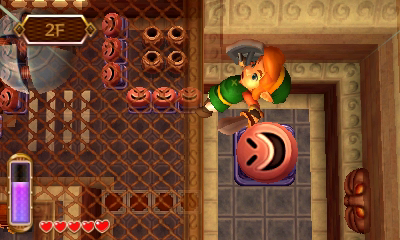
The Tower of Hera in A Link Between Worlds is where the dungeons of the game really start to get good. Although it’s pretty short, I loved climbing the levels of the tower using the Hammer and the Moles, and I enjoyed the use of the wall mechanic to ascend — it was pretty memorable. To top it off, you get hit with nostalgia when you find out Moldorm is back at his old stomping grounds! Overall, this is a solid dungeon from a game that has a lot of great ones.
– Charles Xavier
49. Ganon’s Tower
The Wind Waker

Ganon’s Tower is one of the many shining moments in The Wind Waker. Although the rehash of bosses at the start may be tedious and frustrating, it’s relatively easy to conquer them and advance. Following Phantom Ganon through his maze, getting the Light Arrows, and then the epic climb to what you think will be the end are some of the most exhilarating moments in the game. Then, crossing into Ganondorf’s chamber for the penultimate fight to find the villain with Zelda in his clutches fills you with a sense of, “maybe Link is in over his head”. Lastly, the final showdown with Ganondorf is one of the greatest (if not the greatest) in the series. It’s atmospheric, epic, daunting, and easily one of the greatest dungeons in the Zelda series!
– David Nystrom
48. Wind Temple
The Wind Waker

The Wind Temple is a good dungeon for many reasons. But for me, one stand-out feature is its mechanics. Utilizing Makar to make my way through the temple shook up the usual dynamic found in typical Zelda dungeons, where Link must traverse the area alone. Facing some classic Zelda puzzles that could be solved with Makar’s help was quite interesting in itself. Controlling this companion was easy enough and rather enjoyable once he took flight, which brought some cheer to an otherwise characterless dungeon. Pushing Makar to his gliding limits was a challenge that I really liked too. The tinkle that sounded as he “tootled” around on his cute little legs was also endearing and added to the enjoyment of his company. What more could I ask for? Perhaps a quality boss battle, which is exactly what I got as well! Facing Molgera was pretty exciting. I had to stay on my toes to avoid the sizeable damage that she could cause, making her defeat feel like an achievement.
– Judy Calder
47. Turtle Rock
Link’s Awakening

How can you not love a dungeon where just getting inside requires you to have a boss fight at said dungeon’s entrance? Just that alone should be enough of a reason to appreciate Turtle Rock like I do. However, there’s a lot more to this section of Link’s Awakening than meets the eye. While Eagle’s Tower is more focused on puzzle than enemy, Turtle Rock is the opposite. It requires you to remember everything up until this point on how to beat some of the mini-bosses you’ve encountered throughout the game. What I like the most about Turtle Rock is that it makes for a solid final dungeon in a Zelda title. You have to use everything you’ve learned up until this point and you’re rewarded for your efforts.
– Kristen Rosario
46. Forbidden Woods
The Wind Waker

The Forbidden Woods isn’t a particularly special dungeon, though it’s got a nice touch. Each of It’s honestly the calm, simple approach that draws me to it; when playing this dungeon, I feel like I can just sit back. The Deku Leaf here has to take the cake, being such a simple, yet entertaining gimmick that uses the environment well. Aesthetically speaking, I feel the dungeon’s great, what with its colors and the unique Wind Waker sound effects. The beautiful neon aesthetic of Kalle Demos creates an awesome atmosphere, and the fight is a great improvement over Ocarina of Time’s Barinade, especially with the root-like tentacles that occasionally ambush Link.
– John Piland
45. Color Dungeon

Link’s Awakening
The Color Dungeon ranks as one of my favorite Zelda dungeons because it’s just simple and fun. It was originally part of Link’s Awakening DX, and I was thrilled to see it return for the Switch remake. I love the use of colors within the puzzles, and it’s kind of a relaxing dungeon. It’s not hard, and the reward at the end is worth it. I love how the color dungeon gives you an option of greater defense or greater power as a different kind of reward, and if you change your mind, you can always change your tunic! It’s an easy, fun, optional dungeon to play in Link’s Awakening, and certainly memorable among the many on Koholint Island.
– Heather Beard
44. Divine Beast Vah Naboris
Breath of the Wild
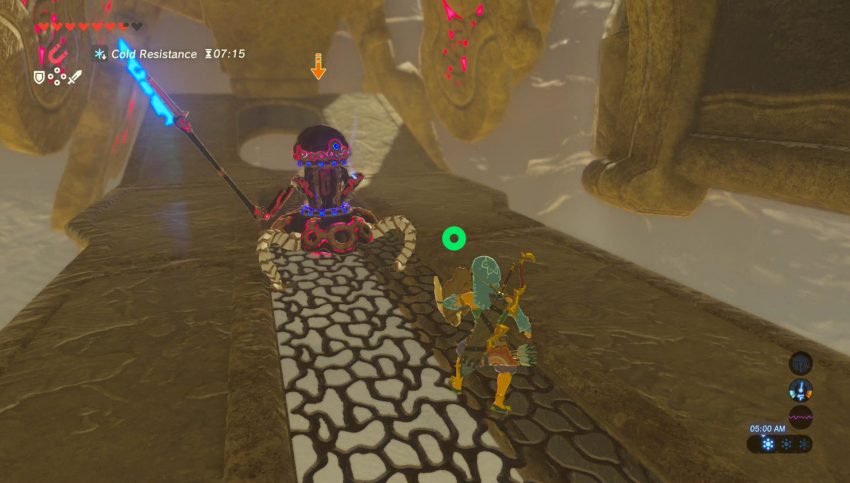
As far as dungeons go in Breath of the Wild, Vah Naboris took the cake as most challenging for me. If you count the whole Gerudo questline, it makes this dungeon worth traveling across the desert for. Naboris has some really fun puzzle elements that made it stand out among the other Divine Beasts, especially when it came to getting into the upper levels of Naboris’ chambers. The rotating and usage of different circuits was a new element that I hope returns in subsequent Zelda games. I felt, especially having done it recently in Master Mode, that it made you think critically. Breath of the Wild’s dungeons were certainly not traditional, but the fighting of Thunderblight Ganon at the end of Naboris certainly made for a great challenge.
– Heather Beard
43. Woodfall Temple
Majora’s Mask

As someone who doesn’t much care for the dungeons in Majora’s Mask, Woodfall Temple does a good job of trying to change my mind. It’s eerie, well paced, and a lot of fun to run through. The music does such a great job of making you feel like you’re in some kind of polluted, creepy shrine. I also think it’s safe to say that, no matter what version of the game you’re playing, the boss battle is epic and unique to what we’ve seen throughout the series. Overall, it does a great job setting the tone for the dungeons that follow it in Majora’s Mask.
– Alasyn Eletha
42. Forest Temple
Twilight Princess

While I wasn’t initially a fan of Twilight Princess‘ poison fog navigation and mischievous monkeys, I’m fully nostalgic for them now. They constitute a fantastic build-up to this dungeon with the introduction of the monkeys and that sense of danger encroaching on Ordon. The pacing of the Forest Temple is nice, too, because you can really feel your progression with every monkey you free. And oh, that Ook fight! So. Much. Fun. The music and Ook himself are so kooky, and when he shows up again during the Diababa fight, I just want to stand up and cheer. Speaking of the boss fight, I like that the dungeon’s puzzles essentially prepare you for it, and the Gale Boomerang is an interesting (if cumbersome) addition to Link’s arsenal. This Forest Temple is a solid introductory dungeon that I’ve certainly grown to love more overtime.
– Alexis Anderson
41. Great Palace
The Adventure of Link
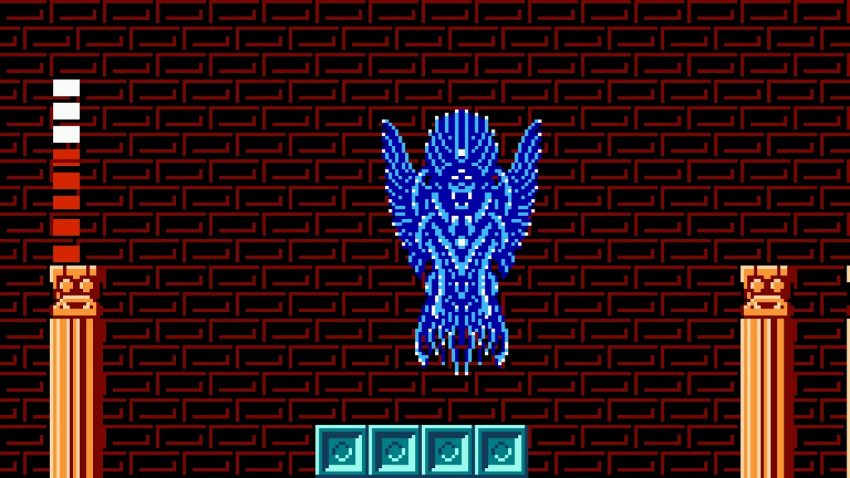
This is the hardest dungeon of any Zelda game. If you think there’s one more difficult, then you’re wrong. Accept this now and make it easier on yourself. Zelda II is notorious for not pulling any punches when it comes to how brutal it can be, and the entirety of the Great Palace is the definition of arduous. From the relentless enemy variety that you’re presented with, to the labyrinthine layout, it’s an endurance trial and a true test of the skills you’ve been honing for the entirety of the journey. It’s not all painful though, as you’re treated to a really awesome theme tune that’s unique to this palace, and the final encounter with Dark Link is thematically one of the coolest fights in the franchise. Conquering this dungeon delivers a sense of triumph that I think is second to none in the series. It may be from the most divisive Zelda title, but the Great Palace is absolutely worthy of this list.
– Bryan King
40. Skyview Temple
Skyward Sword

Skyview does such a great job showing you what you’re in for when it comes to Skyward Sword and its motion controls. The beginning of the game can feel a bit long to most players, but this dungeon is where I think things really start to pick up, especially with the introduction of some of the series’ best enemies, as well as one of the most fantastic main antagonists, Ghirahim. I always urge people to at least get to through Skyview Temple before they give up on Skyward Sword. While it’s unfortunate that it takes that long to do so, this is definitely the point where you start getting a real handle on the motion controls, and start to feel the pull of the story and the adventure that awaits you.
– Alasyn Eletha
39. Divine Beast Vah Medoh
Breath of the Wild

In my first playthrough of Breath of the Wild, Divine Beast Vah Medoh was the first dungeon I did; with the patterns of The Wind Waker hewn into my mind, the Rito area logically the first of the four. Divine Beast Vah Medoh adorns the traits of the eagle it is, tipping its body and wings and soaring above an absolutely gorgeous Hyrule. The ability to control the tilt of the dungeon was an added gimmick that, although a simple shift in angle, allowed for complicated puzzles and ingenious ways to use the runes of the Sheikah slate. The sense of risk and uncertainty diminishes with each terminal, the music building from mystery and danger to something triumphant and bombastic, additionally accompanied by the champion Revali gradually losing his doubt in and disdain for Link as the dungeon progresses. As the player, the dungeon evokes a newfangled sense of accomplishment and defies the gravity of expectations placed upon Link. A dungeon that takes Sheikah technology to the skies, I would describe Divine Beast Vah Medoh as a thrill.
– Alexandria Weber
38. Tower of Spirits
Spirit Tracks

The central dungeon of Spirit Tracks is one that Link returns to six times over the course of his adventure. But let’s be clear. The reason this dungeon is special, and why it is on this list, is because of Link’s fifth and sixth journeys through the tower. The fifth trip might be the absolute pinnacle of puzzle solving in the Legend of Zelda series. This will test the will of even the most veteran Zelda player. Compounded with the rewarding gameplay of destroying pillars with the new Wrecker Phantom, as well as a fantastic battle with Byrne/Staven, it stands out as a personal favorite. Although it might even be considered a piece of cake in comparison to the sixth journey through the temple. This visit will task Link with swapping between all four variations of the phantoms in order to solve the labyrinth of floors. This final trek through the tower is quite possibly the longest and most confusing dungeon in the entire Zelda franchise. It is the absolute best that Spirit Tracks has to offer. There are very few dungeons in the series that give me a more fulfilling Zelda experience.
– Mases Hagopian
37. Misery Mire
A Link to the Past
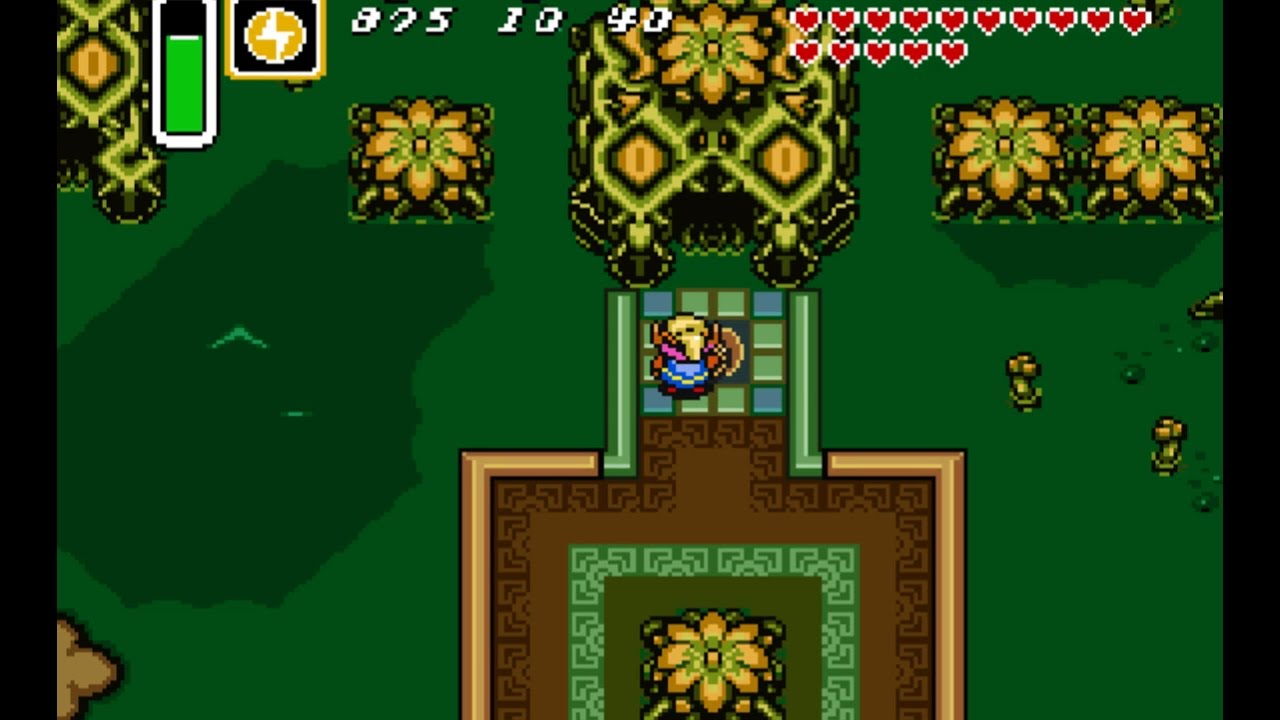
I really enjoyed the complexity of Misery Mire from A Link to the Past. There are so many optional rooms that you can enter and a variety of ways to traverse the dungeon, of course, if you know the game well enough you’ll eventually figure out the quickest route through it. Wizzrobes are introduced into the game here, adding a nice challenge, and there are also some Beamos, which haven’t shown up since the game’s third dungeon (Desert Palace). To this day I still enjoy the dash across the crumbling pathway to get to the chest that contains the Cane of Somaria. Further in, I remember that first room of the lower dark level of the dungeon, where fireballs are constantly being tossed at Link, was such a pain when I first played the game. Vitreous is one of those dungeon bosses that can be easy on some occasions, and pretty difficult on others. Generally I like using either the arrows in the first phase, although it can be tricky to do so. This is arguably the most difficult portion of the fight really, between being limited to the lower portion of the screen, trying to dodge his electric attack, and the massive damage his eyeballs can dish out. The second stage of the fight is much easier, rather than taking forever with sword slashes, you can walk away victorious by spamming 8 arrows straight at him. I also have to add that the exterior of this dungeon is so cool, and using the Ether Medallion to reveal it is a pretty epic moment in the game for me!
– Charles Xavier
36. Great Bay Temple
Majora’s Mask

I know, you’re not a big fan of these “water level” dungeons, but the Great Bay Temple works just as well as the one from Ocarina of Time. What works is that it’s not as grueling as the Water Temple and provides a unique challenge. Even the boss of the Great Bay Temple is more of a challenge. The aesthetic though is the key thing I appreciate the most about this dungeon, as the area doesn’t feel like a stereotypical Zelda dungeon. The gears, the pipes, the metallic walls make it feel less like a “Water Temple” and more like a “Water Factory”. It really acknowledges the fact that Termina is more technologically advanced than Hyrule.
– Kristen Rosario
35. Divine Beast Vah Ruta
Breath of the Wild

Breath of the Wild took a very non-traditional approach to dungeons, and during the Zora quest-line you find yourself face to face with Vah Ruta. Ruta’s design is fairly straightforward and easy to navigate. The water mechanics are easy to figure out and I think they play well with the elephant design of the dungeon. The theme fits Zora’s Domain perfectly, and I couldn’t think of a better dungeon for the Zora quest. Waterblight Ganon is a fun challenge at the end of a fairly easy dungeon, and let’s not forget what a valuable reward Mipha’s Grace is; especially in Master Mode. Vah Ruta is a fun play on water mechanics and is a fun throwback to other water themed dungeons, that’s why it’s one of my favorites.
– Heather Beard
34. Goron Mines
Twilight Princess

I remember the Goron Mines mainly for the fun I had climbing up the walls in my iron boots, and swinging upside down on the magnets attached to the gigantic crane mechanisms. At the beginning, the music sounds as if the cast of Stomp are having a great time banging on metal pipes. Then later on, we have the odd creepy gasp as an ode to Dodongo’s Cavern and the low drawl that reminded me of the Fire Temple in Ocarina of Time. Finding the Goron Elders was a nice way to track your progress through this dungeon. Pressing switches and dispatching fire breathing Dodongos and Bulblins (a lot of Bulblins) was the order of the day here. I thought the boss battle with Fyrus was pretty epic, despite the camera angle making things harder than they needed to be! This is a fairly linear dungeon, but getting hold of the Hero’s bow gives it a thumbs up from me.
– Alison Brunyee
33. Bottom of the Well
Ocarina of Time

While this dungeon may share many elements with its older brother, the Shadow Temple — theme music, aesthetics, enemy types — the Bottom of the Well sticks out to me as the home of the Lens of Truth and therefore the first area in Ocarina of Time to truly provoke its use. Invisible traps, enemies, and pitfalls are plentiful in the depths of the well, as the dungeon trains players to use their newly acquired tool while also executing on elements of surprise and fear that players may not have yet experienced in the game. On top of all that, the Bottom of the Well accomplishes a terror all its own by having Child Link — who is smaller, less equipped, and more vulnerable — explore its literally bloody halls. And don’t get me started on the one-of-a-kind horror of the Dead Hand…
– Rod Lloyd
32. Ikana Castle
Majora’s Mask

Ikana Castle is such a great dungeon because it’s got those classic 3D Zelda vibes. This dungeon is set up for success with such a cool aesthetic and some really strong theme music. It also leaves a lasting impression if you happen upon the dancing Redeads while wearing certain masks. Making your way through Ikana Castle is enjoyable as well, especially if you’re a fan of those textbook Zelda puzzles and traps. Props to King Ikana and his lackeys too, because they more than made up for the disappointment of facing Wizrobe as our mini boss. I appreciated the strategy needed to defeat these enemies, and I loved the comedic and dramatic effect of their dialogue. All, in all, this is a great dungeon with a truly memorable boss battle.
– Judy Calder
31. Skull Woods
A Link to the Past
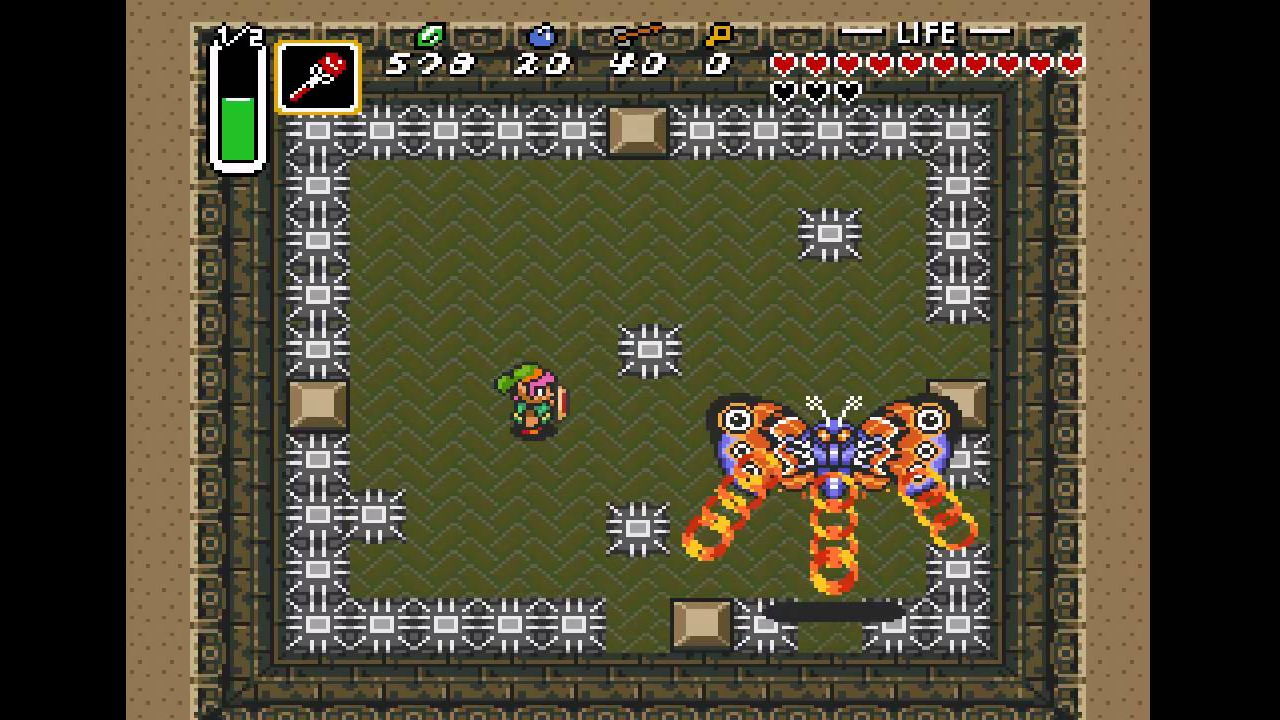
By the time A Link to the Past rolled around, we had gotten used to a certain set of expectations when it came to dungeons. You go into a dungeon, you wander around until you find the new item that bolsters your skillset, you kill the boss, and then you get a piece of the Triforce or a crystal to put in a pedestal. Things were simple, and up to a certain point in A Link to the Past that held true. But then, it did something a bit unexpected, and we started getting dungeons that were a bit more nuanced. No longer isolated to individual caverns or palaces, dungeons could now be comprised of multiple structures, allowing for more complex layouts and challenges, with the Dark World’s Skull Woods being the apex of this design choice. Players undertaking this particular dungeon were subjected to a multitude of entry points and exits; its underground network working against them every step of the way. The in-game map felt fairly limited in its usefulness for the first time in the series, as it was now up to the player to maintain knowledge of how each portion of the dungeon connected to each other in order to progress. This is to say nothing of the aesthetic that Skull Woods exhibits. The Dark World by its nature is a twisted version of the Light World you were exposed to from the game’s outset, but this particular dungeon is the utter antithesis to its light world counterpart. Where the lost woods were a mysterious, albeit magical location that housed the iconic Master Sword, Skull Woods is decrepit, vile, and devoid of hope. These reasons make the inclusion of Skull Woods onto this list more than justifiable.
– Bryan King
30. Death Mountain
The Legend of Zelda
 There’s a beautiful simplicity in the design of the original Legend of Zelda. Aside from the opening crawl that delivers a brief narrative overview of the situation, you’re left to your own imagination on several of its key elements. Most notably among them, is the depiction of the primary antagonist of the quest: Ganon. In the crawl, we’re not told much about him, save for the fact that he’s a jerk that kidnapped the titular princess and it’s up to you to reunite the shattered Triforce of Wisdom before confronting him. When the original Legend of Zelda came out, we had absolutely no expectation of his appearance and what he was capable of, save for some vague artwork in the NES manual for the game that featured a foe cloaked in flame. So, when it came time to venture into the ninth dungeon, there was a genuine sense of trepidation among players. Several of the reasons that I enjoyed the Great Palace from Zelda II that secured a place earlier in this list are prevalent here, but there’s just something about the sense of impending doom and finality that Death Mountain imparts unto the player that’s second to none. It’s sprawling, has a unique music track that capitalizes on a feeling of dread, and is fit to burst with all manner of creature that you’ve encountered up to this point — bosses and mini-bosses alike.
There’s a beautiful simplicity in the design of the original Legend of Zelda. Aside from the opening crawl that delivers a brief narrative overview of the situation, you’re left to your own imagination on several of its key elements. Most notably among them, is the depiction of the primary antagonist of the quest: Ganon. In the crawl, we’re not told much about him, save for the fact that he’s a jerk that kidnapped the titular princess and it’s up to you to reunite the shattered Triforce of Wisdom before confronting him. When the original Legend of Zelda came out, we had absolutely no expectation of his appearance and what he was capable of, save for some vague artwork in the NES manual for the game that featured a foe cloaked in flame. So, when it came time to venture into the ninth dungeon, there was a genuine sense of trepidation among players. Several of the reasons that I enjoyed the Great Palace from Zelda II that secured a place earlier in this list are prevalent here, but there’s just something about the sense of impending doom and finality that Death Mountain imparts unto the player that’s second to none. It’s sprawling, has a unique music track that capitalizes on a feeling of dread, and is fit to burst with all manner of creature that you’ve encountered up to this point — bosses and mini-bosses alike.
– Bryan King
29. Temple of the Ocean King
Phantom Hourglass

The Temple of the Ocean King is one of a kind when it comes to the Legend of Zelda series, a central dungeon that Link will visit several times throughout his journey in Phantom Hourglass. With each visit through the dungeon, Link will dive further down to the floors below, looking for new Sea Charts to unlock new sections of the overworld. What I’ve always loved about the Temple of the Ocean King is that every time Link acquires a new item from elsewhere in the game, it always has a use in the dungeon. Whether that is sending Bombchus through narrow corridors, using the Grapple Hook to travel across distant gaps, or using the Hammer to launch yourself over walls, the dungeon takes advantage of every single item in Link’s inventory. Perhaps it is a bit divisive, as the dungeon relies on both a stealth mechanic and a time element, but I feel this adds to the uniqueness of the dungeon. It certainly made navigating the floors a very uneasy experience, but it was one that is both very memorable and very distinguishable.
– Mases Hagopian
28. Lakebed Temple
Twilight Princess
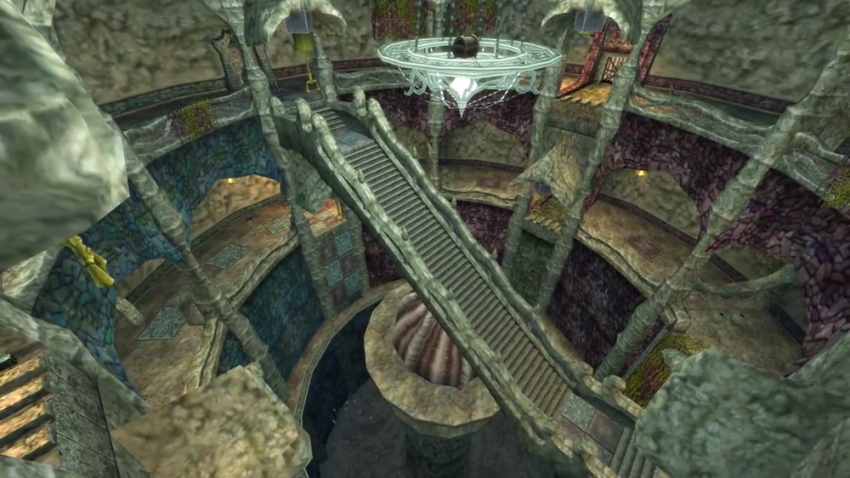
Water dungeons in Zelda games can be, putting it kindly, very hit or miss. Lakebed Temple from Twilight Princess is an example of a water dungeon done right. The water physics that exist are few and far between, so you’re not relying on having to try and navigate with limited or poor control. Instead, the dungeon uses water almost as a source of power, turning gears and allowing access deeper into the dungeon. When you do have to navigate through water, it seemed like Nintendo learned their lesson from Ocarina of Time, and made swapping to the iron boots seamless. Gone are the days of menu navigation, and all you need to do is press the button with the boots mapped to it. Of course, as has been the custom since A Link to the Past, your reward for navigating the halls of this dungeon is the Hookshot (named Clawshot, in this particular game). Usage of your item comes late in the dungeon, but is required to defeat the boss, Morpheel. Once Morpheel is dispatched, the Clawshot opens up quite a bit of navigation and treasures on the overworld. It seemed like mistakes of the past became learned lessons with this dungeon, and Nintendo hit it out of the park.
– Doug Kwiecinski
27. City in the Sky
Twilight Princess
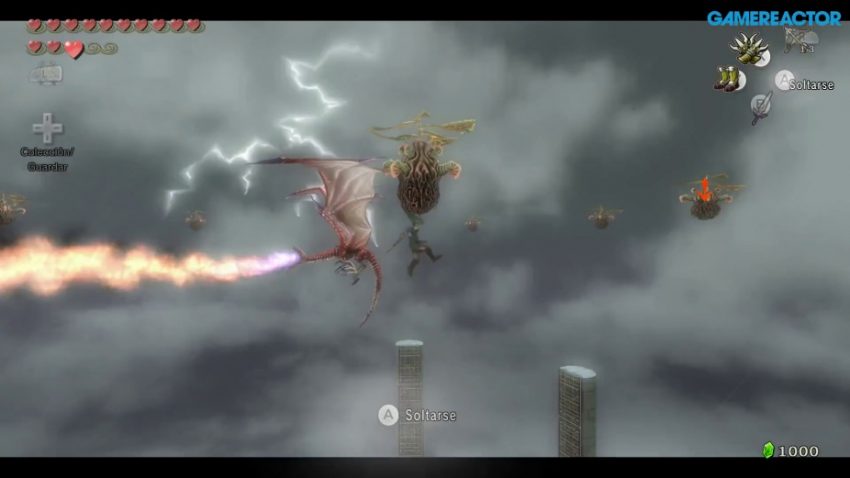
City in the Sky is about as unique as it gets for Zelda dungeons. Few dungeons in Zelda find themselves floating kilometers above the surface, and even less rival this one in terms of greatness. This temple doesn’t hold back, taking advantage of its location through puzzles, enemies, traps, and items, as well as blending inside and outside portions spectacularly. Finally, it’d be a crime not to mention the eerie yet all so fitting track that plays as you traverse its halls to get the final mirror shard.
– John Piland
26. Palace of Twilight
Twilight Princess

Twilight Princess’ penultimate dungeon is a prime example of excelling through presentation alone. With its distinctly alien architecture and oppressive atmosphere, Midna’s homeland stands apart from any other locale in the series. To some extent, it serves as a climax to the vengeful imp’s personal mission. Admittedly, the dungeon design is pretty straightforward, but the place just oozes personality. Zant’s Hand is a worthy successor to the Wallmaster, resulting in some genuinely intense chase sequences. Additionally, Link’s sol-infused Master Sword just feels so empowering, while the zany boss fight against Zant himself is one for the ages.
– Brandon Schmitz
25. Lorule Castle
A Link Between Worlds

This dungeon is absolutely fantastic and near perfect. This climatic area of A Link Between Worlds has everything you could want in a final dungeon. It features challenging puzzles which make use of every mechanic you had previously learned in the game. It has awesome fights against challenging enemies and previous bosses. But what makes this dungeon stand out to me the most is that it has one of the best pieces of Zelda music in existence. As you progress through the dungeon, the music scales in intensity. A Link to the Past is the most nostalgic Zelda game to me, and this final area in its sequel, while very different from its predecessor, works fantastically to create an epic climax to a great game.
– Adam Barham
24. Palace of Winds
The Minish Cap

I’ll admit I was late to the party with The Minish Cap, but after recently playing through it, it became cemented as a top-five Zelda title. If the aesthetic, puzzles, and combat weren’t enough, the Palace of Winds sold me completely. Being the penultimate dungeon in the game, the Palace of Winds tests all your learned skills, throwing a pretty steep challenge at you. What makes this dungeon unique is the emphasis on platforming, yes, platforming in a Zelda game. This seems like a strange concept, as most games in the series have limited ways of moving between platforms. Utilizing the Roc’s Cape, this dungeon’s item, Link gains the power of both jumping and limited flight. The most striking feature of this dungeon is the use of a sort of third dimension. Platforming is not limited to moving from level platform to level platform, but also falling through gates to lower platforms and jumping up into the clouds. This gave me a feel similar to A Link Between Worlds, about a decade ahead of its time. The boss of the dungeon, a large red Gyorg, has as perfect utilization of Link’s splitting mechanic as well as usage of the Roc’s Cape. The dungeon is long, it is epic, and it is challenging — all the things I look for in a great dungeon.
– Doug Kwiecinski
23. Hyrule Castle
Twilight Princess

This final dungeon has everything that the final area of a video game should have. I especially appreciate that it starts in the outer courtyard with no music. It gives the area an intense and eerie feeling. From there, the player proceeds inside to progress through the ruined and overrun castle. It makes proper use of all of the items and mechanics of Twilight Princess. This version of Hyrule Castle has fantastic fights, cool puzzles, epic music, and a great conclusion to a great Zelda game. And this area resolves almost everything too — you’re helped by old friends to take down old enemies and restore the kingdom. It really contributes quite well to the story of the game.
– Adam Barham
22. Ganon’s Tower
A Link to the Past
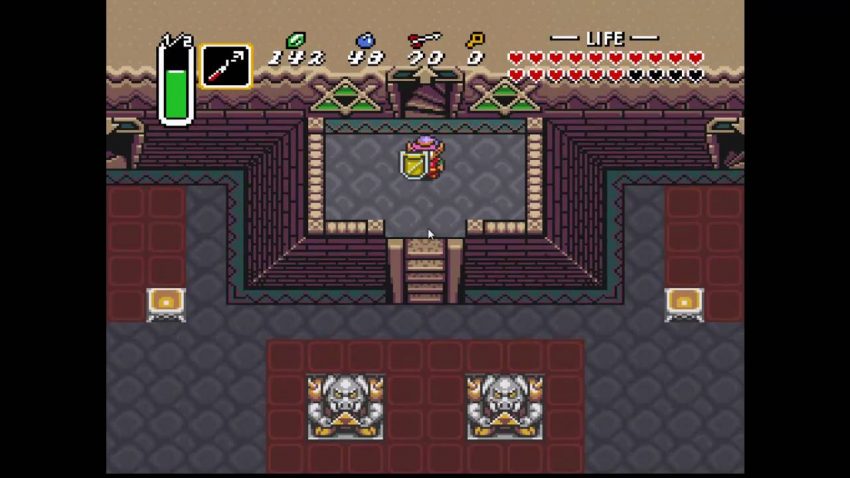
It should come as no surprise that from my favorite Zelda game comes one of my favorite Zelda dungeons. The (typical) journey from Dark Death Mountain to Ganon’s Tower isn’t particularly treacherous, but like The Legend of Zelda before it, you come face to face with a handful of Lynels. The real challenge comes within the dungeon. It’s not as winding or disorienting as Death Mountain in The Legend of Zelda, but that’s made up for with the enemies thrown at Link. Within the dungeon, you will have to fight past each of the three Pendant dungeon bosses (Armos Knights, Lanmolas, Moldorm) in order to make your way to the top to face off against Aghanim, once again. Each boss fight has a twist that makes it harder than the first time you fought it, and several enemy gauntlets stand between you and these battles. Your first time through will definitely test your patience and will, but Link is more than strong and capable enough to survive the climb. Defeating Aghanim again reveals his true identity: Ganon.
– Doug Kwiecinski
21. Final Divine Beast
Breath of the Wild

This dungeon is the ultimate culmination of the Divine Beasts in Breath of the Wild, maintaining the no-less-than-genius pairing with the Runes of the Sheikah Slate and the mysterious, dangerous atmosphere that accompanies them all. The dungeon requires the deciphering of four separate rooms, each tailored to the style of puzzles found in the four main Divine Beasts. Literally like clockwork, the dungeon utilizes spinning gears in order to reanimate the puzzles; and the wisdom of the player is truly tested against puzzles with a size monumental in comparison to Link. Like all the Divine Beasts, it feels as if Link is setting things right from the inside. The dungeon ends with a boss fight that subverts expectations, as a monk expected to simply give Hylia’s blessing instead stands to fight Link as one final test of his competence. Although the player is likely well prepared to fight Calamity Ganon by the time this DLC dungeon is reached, if not already having done so, the Final Divine Beast is a great testament to the multi-solution puzzles in Breath of the Wild.
– Alexandria Weber
20. Eagle’s Tower
Link’s Awakening

Eagle’s Tower from Link’s Awakening is the most challenging dungeon in the game. Just figuring out how to get to the tower is a challenge in itself. Any wrong move on one of the floors of Eagle’s Tower has you falling back to square one. What makes this dungeon work for me is having to deal less with enemies and more with just figuring out how to solve the puzzle that is climbing the tower itself. That doesn’t mean the dungeon boss is a pushover though, as the titular eagle that waits at the top of this tower is easily one of the toughest bosses of the entire game.
– Kristen Rosario
19. Dragon Roost Cavern
The Wind Waker
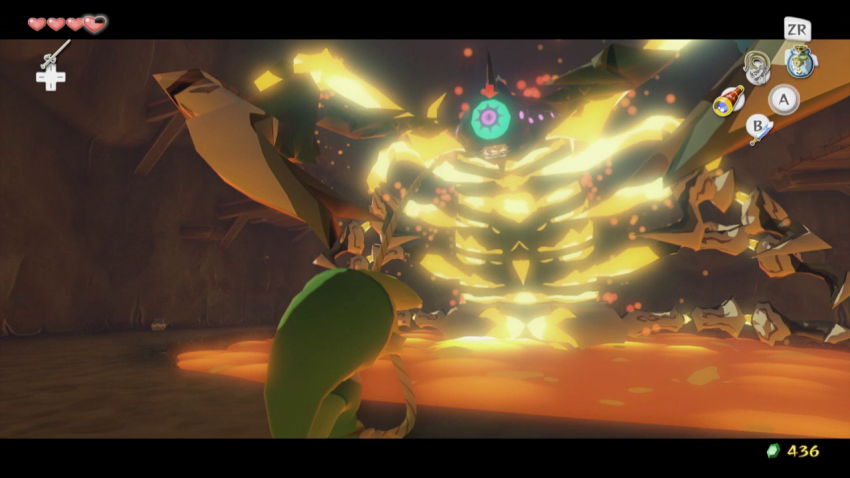
As the first dungeon in The Wind Waker, Dragon Roost Cavern showcases the fun-to-traverse style of most of game’s dungeons. I remember almost everything about this dungeon from the initial puzzle, to the warping pots in the next room, to the introduction to water jars, to the moments when the dungeon takes you outside, to the great use of the grappling hook! I think the Gohma boss fight is really fun with its use of the hook, too. And I love when Gohma’s exoskeleton starts to crack! Finally, the immediate effects of Link’s heroics are felt at the end of the dungeon with Valoo’s temperament shift and Prince Komali’s confidence growth, which makes completing it all the more satisfying.
– Alexis Anderson
18. Inside the Deku Tree
Ocarina of Time

A good intro dungeon can really set the tone for an entire game. It needs to strike the right balance — accessible yet challenging, explanatory yet not heavy on exposition. Get it wrong, and you might lose a new player. Get it right though, and you might hook them for the rest of the game. Fortunately, Inside the Deku Tree not only falls on the side of the latter, but smashes it out of the park. Offering what I would call the best intro dungeon in the entire series, this temple eases you in with its welcoming presence of the Great Deku Tree, calming music, and advice from Navi, but it then let’s players explore and do what Link does best in dungeons: find items and solve puzzles. The core mechanics of the game, such as diving, shooting, lighting torches, and more are all taught to the player in a fun dungeon that never overstays its welcome. Not only is the dungeon mechanically sound, but there’s some nice character moments with the three Deku Scrubs leading you into Ghoma. There are a ton of moving pieces in this dungeon, and it’s a testament to Inside the Deku Tree that it accomplishes everything it sets out to do and more. Best intro dungeon in the series? I think so!
– Andy Spiteri
17. Ganon’s Castle
Ocarina of Time

The goal of a final dungeon is to force the player to utilize all the skills they have developed throughout the game and to build anticipation for the final battle. Ganon’s Castle remains the template for how to create an amazing dungeon in a 3D Zelda. The outer rooms (which feel like predecessors to Breath of the Wild’s Shrines) offer a host of interesting and clever puzzles that force the player to use a variety of skills and tools to complete. The upper tower portion pits the player against the best enemies from the entire game, challenging the player with epic tests of skill and strength. Add a lush, imposing atmosphere and an intoxicating organ theme that drips with gravitas, and you have one of the most unforgettable sequences in one of the best games ever made.
– Sean Gadus
16. Forsaken Fortress
The Wind Waker

The Forsaken Fortress is not only a fantastic dungeon, but a real tale of two halves. At the beginning, with no sword to speak of, you find yourself dodging search lights and using a barrel as a disguise in order to hide from monsters. I found this quite intriguing because it perfectly shows how Link is still a bit wet behind the ears at this point in his adventure. You can’t use your sword to cut down the enemy; you have to use stealth. The atmosphere is tense, the fortress design dark and imposing, and to top it off, you can’t make a dent on the Helmaroc King. Upon your return to the Forsaken Fortress, with the Master Sword in hand, you feel a lot more in control. The fight with Phantom Ganon is a great warm-up for what is to come. Once you have the Skull Hammer, you can open up paths barred to you before. But the real reason I rate this dungeon is the rematch between you and the Helmaroc King. There is something very satisfying about splitting open his mask and giving him some payback. During his swansong, you watch as he flies into the sky illuminated by searchlights. This is such a dramatic end to a boss fight, and it shows how far you’ve come on your journey as a hero.
– Alison Brunyee
15. Sky Keep
Skyward Sword

The Sky Keep in Skyward Sword is one of the strongest moments in an already strong game. It’s non-traditional in a variety of ways, the entire dungeon being a puzzle to name the biggest. There’s also no real boss, item, or even map. Despite its game being so linear, the dungeon itself can actually be completed in fairly non-linear fashion, by simply sliding a different room into your path from one of the consoles. In many ways, it actually works like a Divine Beast. It also puts you into different environments from throughout your journey to the surface, putting the skills you’ve acquired throughout the game to the test. And the reward? You get to wield the complete Triforce!
– David Wayne Nystrom
14. Temple of Time
Twilight Princess
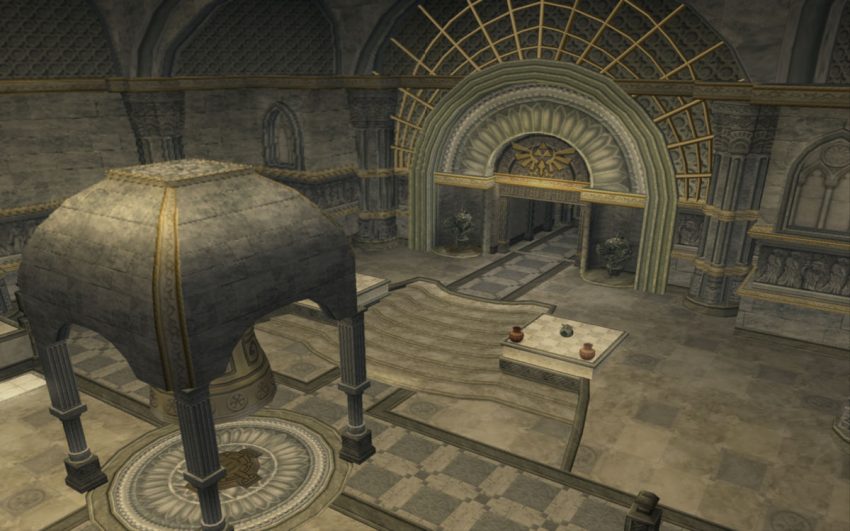
The Temple of Time dungeon from Twilight Princess is something truly special. The very concept of it alone – exploring the hidden depths of the temple which houses the Master Sword, cemented in the heads of Zelda fans since Ocarina of Time – is insane. Then you have the great aesthetic, great background music, and most importantly, great pacing. If that’s not enough, there’s what may be the most epic mini-boss in Zelda history: the Darknut. This high-stakes, fast-paced battle puts even Breath of the Wild‘s Lynels to shame. Battling to music of epic proportions, you must roll, jump, and use your arsenal of acquired skills to disarm this thing, sending it further into berserker mode until you kill it — or it kills you. It’s because of these various elements that this dungeon one of the best Twilight Princess has to offer.
– John Piland
13. Tower of the Gods
The Wind Waker

The Wind Waker‘s Tower of the Gods is a strange, other-worldly, partially futuristic behemoth in the middle of the game. While the first floor of it can be somewhat frustrating with the rising and falling of the water, every moment beyond that is a thrill. From encountering Darknuts for the first time to earn the bow, to guiding the strange statues to the central pillar through some interesting puzzles, and then to the climb around the outside of the tower to face the boss, it feels like pure epic Zelda. The lore potential around the tower too, as a trial for the Hero of the Winds (or whoever challenged it), who built it, and so forth is filled with enough of its own aura to make it one of the most memorable dungeons in the series.
– David Wayne Nystrom
12. Lanayru Mining Facility
Skyward Sword

I’m a sucker for time travel, so it’s no surprise that the Timeshift Stones in Skyward Sword are one of my favorite mechanics in the entirety of the series. Exploring this mechanic leading up to the dungeon was already fantastic by itself, with the terrain around Link going from a desert wasteland to a lush, green, and vibrant civilization of robots in just a second. In the dungeon, it added a dimension completely foreign to the series, the player having to think with a completely different angle. Each room was to be approached with an added mindset of not only how it works in a three-dimensional space, but how it works with a shift in time. The questions of what will and won’t appear, what obstacles need to be accounted for when the shift occurs and how to navigate based on that added twist are questions I absolutely loved to ascertain. The dungeon and the area around it was stuck in an ever-changing dichotomy of ruin and prosperity, and I absolutely loved that Skyward Sword saw it to its full potential, the music even changing along with the time. Additionally, the very end of the dungeon is a drop-dead gorgeous long hallway of large robots, the line of them greeting you with a silent reminder of their temporal fate and your heroism amidst it.
– Alexandria Weber
11. Water Temple
Ocarina of Time
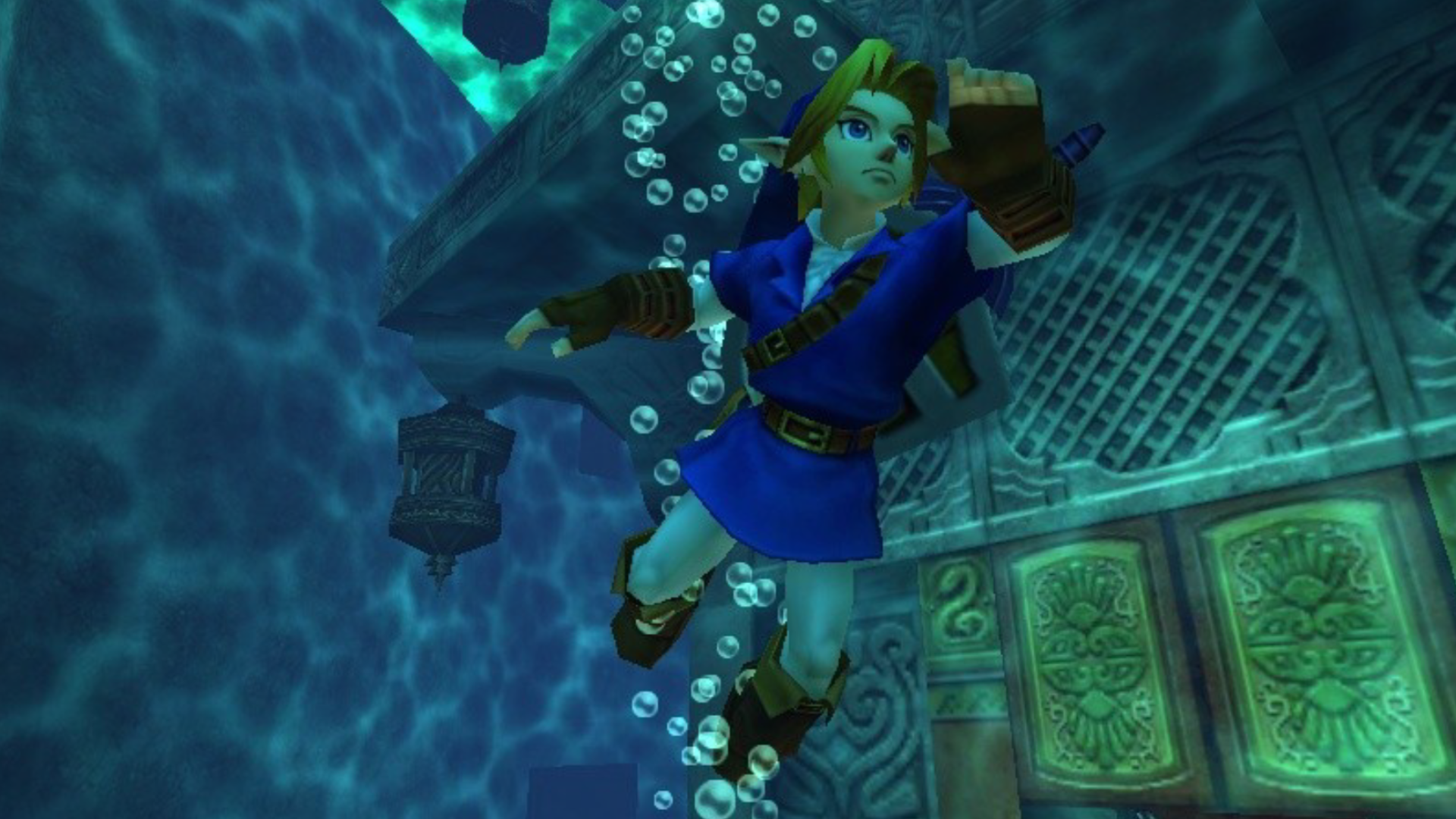
I remember going into this dungeon for the first time and hearing all the negative talk for it. I never expected that this tricky area of challenging puzzles to become one of my favorite dungeons! The boss fight is not the best, admittedly, but the mini boss is quite good! The Water Temple, overall, is quite challenging, but that’s also why I like it — it takes some thought and careful planning. Before I went into it, I asked some experienced friends of mine how to approach it, and I received some great advice for it: always backtrack after changing the water level. I only missed one key while playing through that dungeon thanks to that advice.
– Adam Barham
10. Earth Temple
The Wind Waker
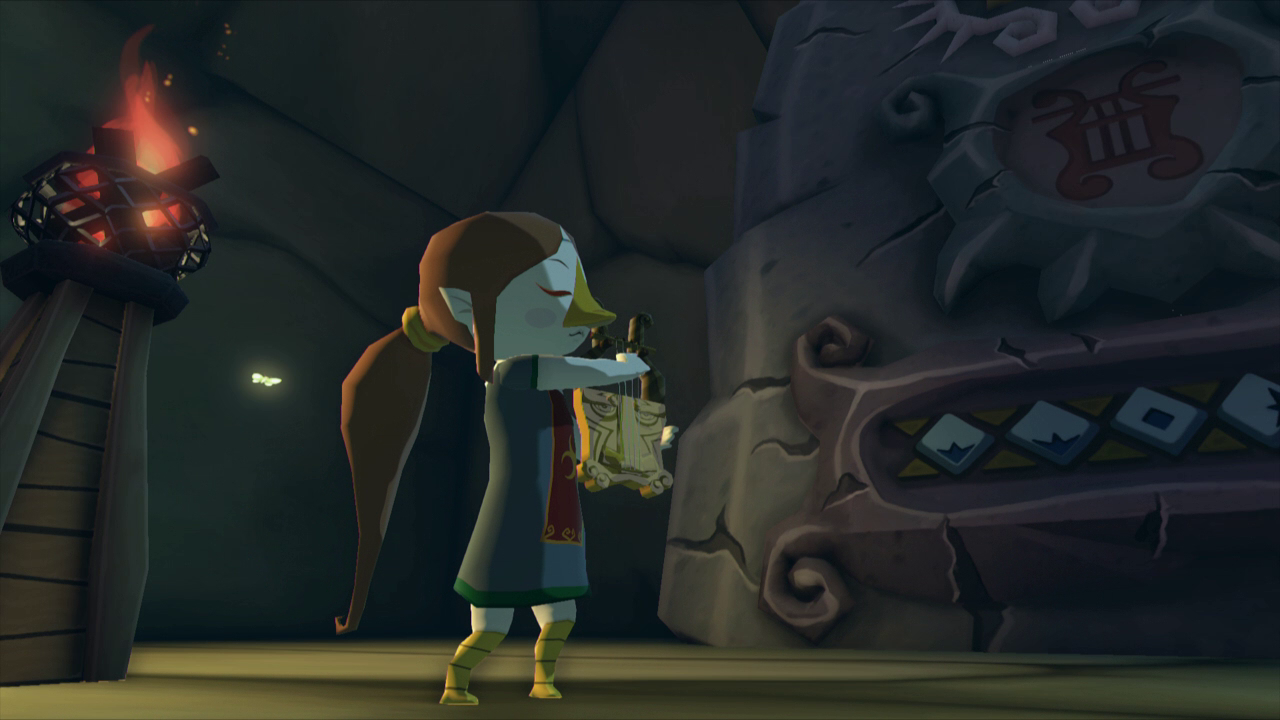
Earth Temple is easily one of my favorite Zelda dungeons of all time. For me it holds a lot of nostalgia from playing The Wind Waker as a kid. The dungeon is fairly long, but it’s enjoyable. Being able to use the element of light as puzzle mechanic makes it a fun challenge, and the dungeon itself is fun to explore and look at. There’s also the fact that you have to use Medli to help you solve many of the dungeons puzzles. The Mirror Shield is an essential pick-up to help finish the dungeon, and just a good shield. The dungeon feels iconic and has every hint of a good Zelda dungeon. It’s challenging, the rewards are worth the challenge, it fits within the story, and it has a fun boss round it out. That being said, Jalhalla is a tricky yet fun boss and a good way to finish things out! The Earth Temple ends with Medli and Link playing the Earth God’s Lyric and more of the Master Sword restored. As a whole the Earth Temple is a challenge, but one of the best in the game and in all of Zelda.
– Heather Beard
9. Shadow Temple
Ocarina of Time

I feel like Ocarina of Time has stellar dungeons across the board, with quite a few that are memorable in various ways. But for me, the Shadow Temple takes the cake because it’s the first dungeon in Zelda to have deeper symbolism attached to it. The overall theme of the Shadow Temple is death and the afterlife. It contains many obstacles that are torture devices, leading Zelda fans to theorize the temple was used for execution and interrogation purposes. Additionally, the ferry ride to get to the final portion of the dungeon is obviously a parallel to Greek mythology, in which Kharon uses his ferry to transport souls across the rivers Styx and Acheron. The use of the Hover Boots and Lens of Truth in this dungeon are necessary to complete it, but it’s actually pretty deceptive. To conclude, I will hold that Bongo Bongo is the most frustrating boss in the game, between him constantly banging on his drum and his attack that swipes Link off the drum if his hands aren’t stunned fast enough.
– Charles Xavier
8. Hyrule Castle
Breath of the Wild
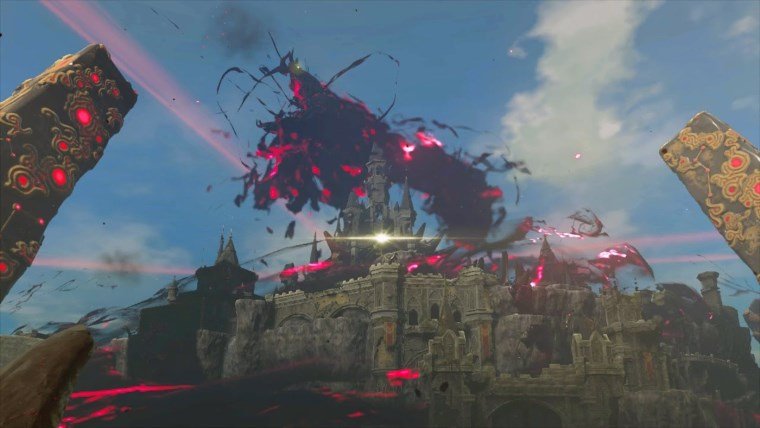
Hyrule Castle from Breath of the Wild, where do I begin? I like to think of this dungeon as one massive game of, “I dare you.” You have a choice of when to tackle it. Did you wait until you had a healthy supply of meals and decent armor? Or went for broke, and snuck in early through the back passageways to get the Hylian shield? There is always the risk that you might be completely pulverized, but for me, that’s half the fun! I love the atmosphere of this dungeon, it’s a dangerous place with Malice smothering the castle walls, Guardian Skywatchers patrolling the skies and some of the toughest of Ganon’s minions within. And I couldn’t talk about Hyrule Castle without mentioning the brilliant soundtrack; it makes you feel super excited scaling the heights on your way to the final confrontation with Calamity Ganon. I wish the castle could have had a few puzzle elements mixed in, and maybe some words of encouragement from the Champions as you went along. But otherwise, I think this dungeon is a highly memorable one.
– Alison Brunyee
7. Spirit Temple
Ocarina of Time

I’m a sucker for desert dungeons, and Ocarina of Time’s Spirit Temple stands among the best of them. Ganon’s Castle may be that game’s final dungeon, but the Spirit Temple feels like the ultimate test of everything I’d learned up to that point. The advent of time travel — completing one chunk of the dungeon as Young Link and the other as Adult Link — is so ingenious that I wish more temples had incorporated it. As one of Ocarina’s longer dungeons, the Spirit Temple’s design is both complex and easy to navigate. The location itself boasts a palpably sacred aesthetic, the Iron Knuckles are still that game’s most fun enemy encounters, and the Mirror Shield is gaming bliss incarnate. Breath of the Wild 2, you know what to do.
– Brandon Schmitz
6. Snowpeak Ruins
Twilight Princess

This dungeon has so much style. The trek up to it is cool, as Link runs into snow wolves and snowboards! This trip also adds to the Ruins’ feeling of isolation and remoteness. Another key to that feeling and its uniqueness is that it’s a big, empty mansion. It is Shining-esque, promoting unease and cabin fever which totally pays off when Yeta turns demonic at the end. Some of the slipping-and-sliding, puzzles, and wolf segments of the dungeon can be frustrating, but the music, Yeto and Yeta’s love story, and overall vibe make this one of the most memorable dungeons in the series for me. The fact that the dungeon is mostly a fetch-quest for soup ingredients is also incredibly campy, and I truly love it for that.
– Alexis Anderson
5. Stone Tower Temple
Majora’s Mask
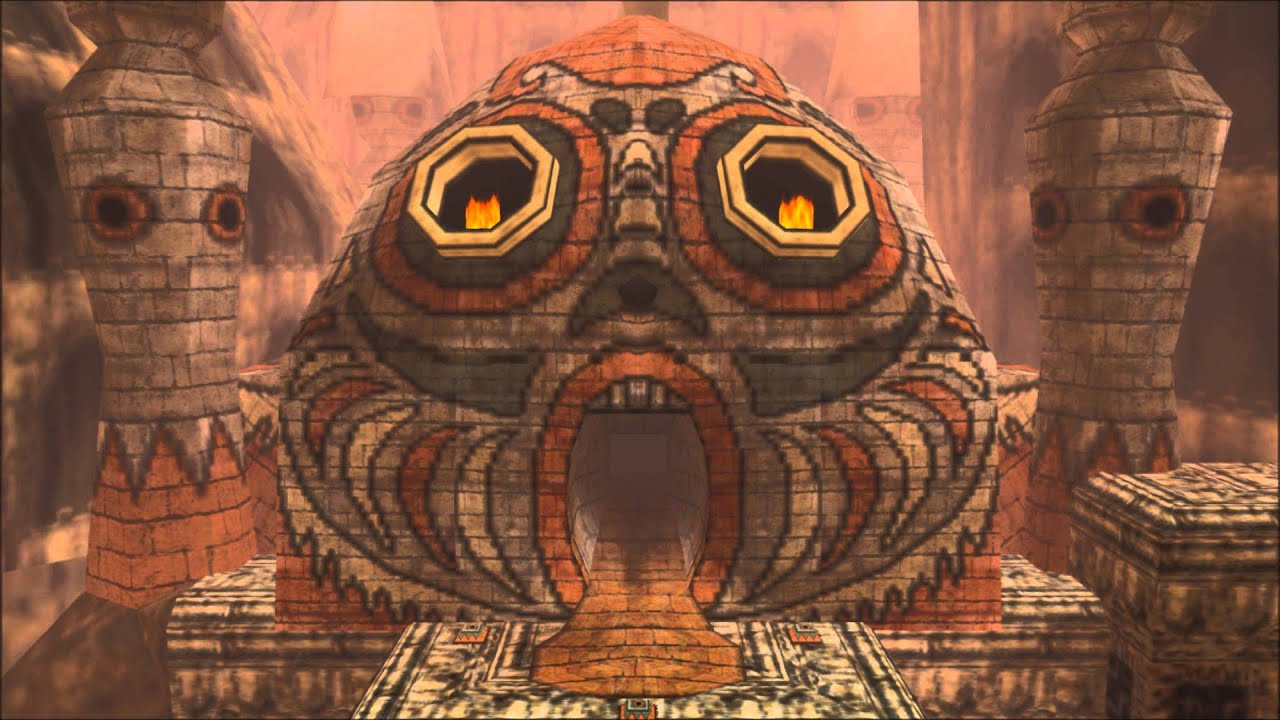
Stone Tower Temple’s main mechanic of flipping itself upside down is one of the most brilliant mechanics in any Zelda dungeon. First, the designers of Majora’s Mask found a way to double the length of the dungeon without making twice as many rooms, always a win for designers working on a tight schedule. Second, the dungeon innately rewards the player’s careful observation of the environment and the player’s spatial understanding of the dungeon’s layout. Smart players will notice chests tucked away in unreachable spots and there is a real “Eureka” moment when you can pick up the treasure in the upside down portion. Third, the temple has two excellent miniboss fights in Gomess and The Garo Master. When taken together, the player gets the privilege of playing through one of the most unique and engaging dungeons in the entire series.
– Sean Gadus
4. Arbiter’s Grounds
Twilight Princess
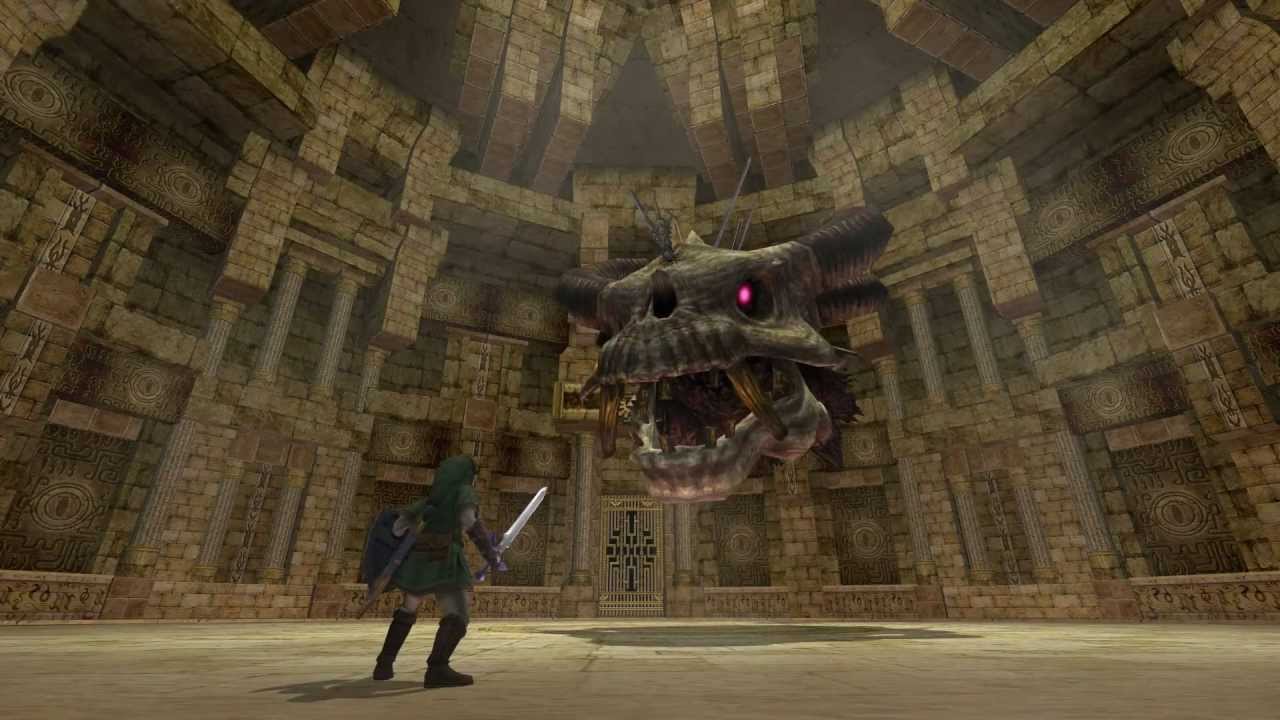
My favorite Zelda dungeons are often those that inform the player of that game’s world and mythos — one that feels like a once-occupied locale with contextual purpose. An abandoned prison in the Gerudo Desert, Twilight Princess’ Arbiter’s Grounds is one of the relatively few dungeons that lives up to the name. Indeed, it goes all in on capturing the feel of a haunted tomb, boasting some of the game’s more devilish traps and puzzles. Hidden floor spikes and quicksand abound, not to mention the Poes scattered throughout the prison. And don’t get me started on the Spinner, which is easily one of the series’ most inventive creations. It all culminates in the oft-celebrated showdown with Stallord, whose grand scale and subversive nature cement it as one of the greats.
– Brandon Schmitz
3. Ancient Cistern
Skyward Sword
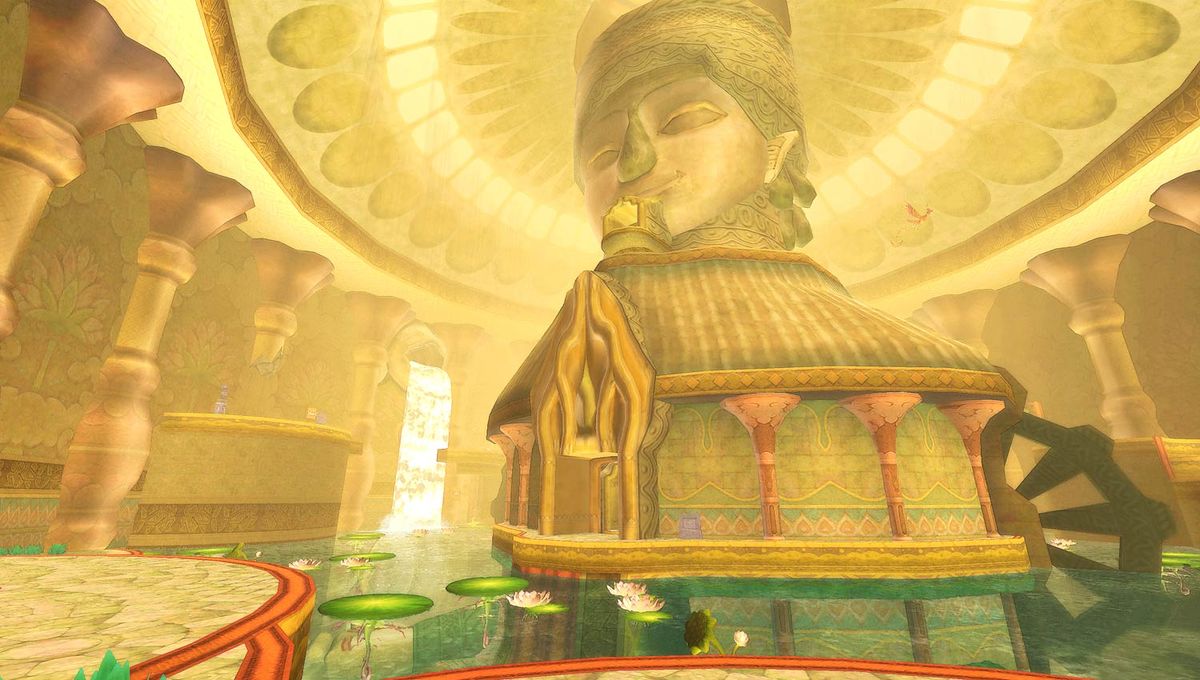
If Skyview Temple doesn’t convince you that Skyward Sword has some of the best dungeons in the entire series, Ancient Cistern will. This dungeon is everything a Zelda dungeon should be and more. First of all, it combines elements, making you feel like you’re in both a water dungeon and a shadow dungeon. On top of that, the puzzle of moving the central statue up and down is so satisfying. There are also some really fascinating tricks you can do in this dungeon if you’re a speedrunner, like falling below the dungeon itself and bypassing it almost entirely. Which is kind of sad, because going through this dungeon is a lot of fun, but I can’t help feeling like a total badass when I do it! Lastly, Ancient Cistern has, hands down, the most epic boss battle of the entire franchise. How can you not be hyped when fighting Koloktos? It’s just such a solid dungeon, and often the one I compare most other Zelda dungeons to.
– Alasyn Eletha
2. Sandship
Skyward Sword

While The Lanayru Mining Facility introduced Time Stones and The Pirate Stronghold had an interesting take on the concept, The Sandship took the concept to its pinnacle. Once you receive the bow after the epic Scervo fight, it’s obvious to most players that they need to use the bow on the glowing blue time stone in the mast. But this simple application of the time stone mechanic opens the player up to a variety of clever challenges as they try to switch from present and past to clear barriers and unlock rooms. The dungeon truly requires the player to understand the clever verticality inherent in the ship’s design. Additionally, because the player can’t always see the effect the Time Stone has on different rooms due to the multi-floor design, they have to experiment to complete the rewarding puzzles. Overall, The Sandship probably could have hosted additional mechanics, but Nintendo proves again and again that when applied in clever ways, simple but elegant game design yields rich results.
– Sean Gadus
1. Forest Temple
Ocarina of Time
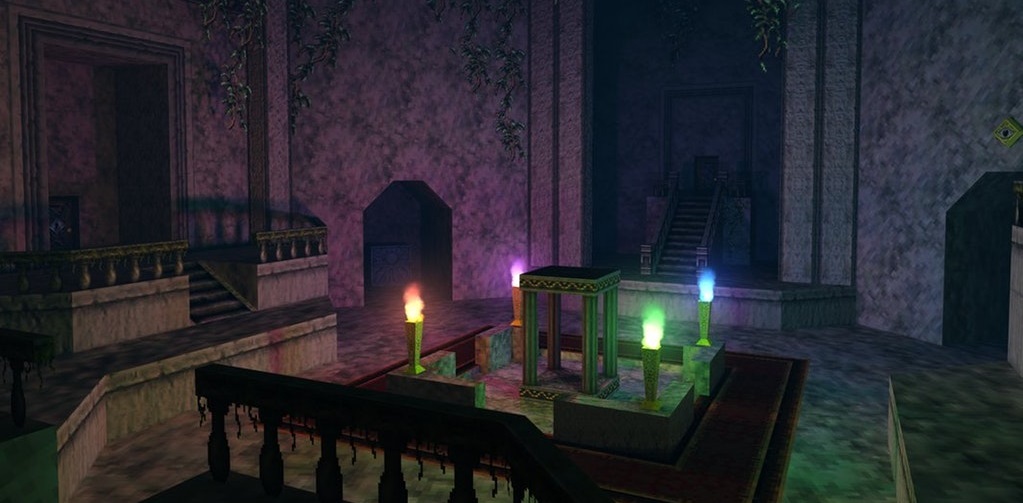
At last, we reach the number one spot! The Forest Temple deserves this place for so many reasons, but let’s start with the sheer atmosphere of this dungeon. It has a really spectacular aesthetic: a long-forgotten mansion, slowly being reclaimed by nature, and accompanied by the most mysteriously captivating musical theme. Simply put, the Forest Temple is hauntingly beautiful from the get-go. And speaking of haunting, we are treated to a really intriguing scene with the Poe Sisters when we first enter the main area of the dungeon. The Poe Sisters really add to the mystery of the Forest Temple, encouraging the player to think beyond the game itself and into the lore behind this dungeon’s history. Did the sisters belong to the temple and suffer some ill-fate within its walls? Did they play a part in its disrepair, or had they simply taken up residence in its abandonment? Who knows…
As we venture deeper into the Forest Temple, the player is faced with some classic puzzles, including moving blocks and stepping switches. However, one thing that stands out in particular is the twisting hallway that literally turns part of the dungeon on its head. Although it wasn’t a traditional Zelda puzzle per se, the twisting hallway was certainly an obstacle on a larger scale, and without the necessary pieces (arrows and keys), you simply couldn’t progress in the right direction. It’s a memorable gimmick that was well utilized in this temple.
Lastly, lets show some appreciation to the big, bad boss of the Forest Temple. The whole setup of the battle with Phantom Ganon is a winner. We’re lured into a false sense of security upon entering a seemingly empty art gallery, only to have our exit blocked as an ominous laugh permeates the room. This, coupled with the initial fear of an unexpected battle with the King of Evil himself, is sure to have caused a shock to the system for lots of players. At least we could breathe a sigh of relief when we realized it wasn’t Ganondorf in the flesh. The battle itself was challenging, but at the same time lots of fun, especially because the Master Sword became the equivalent of a baseball bat! It’s a satisfying victory when you’ve managed to get your technique down to an art!
– Judy Calder
And there it is! Over 30 staff polled, over 20 writers giving their testimonies, and one definitive list that ranks the Top 50 greatest dungeons in the Legend of Zelda series! We want to know what your thoughts are! Did you find the list agreeable, or were some dungeons ranked wildly off? Which dungeons were lower than they should have been? Or higher? And of course — which dungeons are the biggest snubs that didn’t make the list?
We want you to let us know in the comments below! Thanks for reading everyone!
Andy Spiteri is the Editor-In-Chief of Zelda Dungeon. He’s furiously penning a rant about the exclusion of the Fire Temple as we speak. Follow him and the rest of the Zelda Dungeon Team on Twitter here!

Andy Spiteri is a Manager of Zelda Dungeon, Host of The Zelda Cast podcast, and Owner of Omega Metroid. Probably drinking a Tim Horton’s Double Double as you read this.
Business: andy.spiteri@zeldadungeon.net



